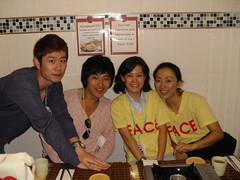
But when I left you, I was talking about hand signals and the fact that they totally worked...for the most part. I hold up my hand and put up either one, two, or three fingers. One finger means projections, two fingers means sound, and three fingers means both together. Then when I extend my arm, they push their respective buttons. Of course, I’ve never called a show this way, so it was a bit of a learning process for myself as well as my crew, and professor Jakyung Seo was instrumental in her role as translator while I explained and rehearsed the system. But we quickly realized that we needed a system in case there was a problem. What happens if they miss a cue? What happens if the actor jumps a line? And out of necessity, the emergency post-it system was born. If an operator believes there is a problem, they raise their hand. I then write on a post-it the number of the cue that I wish to be taken next and hand it to them. Then, the next time that I put my hand down, they execute that cue. Whew! And if I believe there is a problem, I just hand them a post-it with the number of the cue that I want to go next. Thank heavens both of my operators can quickly read numbers in English! The Korean language does not write the same numerals as we do. They have their own entirely unique numerical characters. They are “dok dok ke”, very smart.

The whole process would have been much easier, however, if I didn’t have to cope with having to locate my lost baggage containing all of my tools and supplies while simultaneously trying run and prepare for the tech and dress rehearsals! But that is a story for another time. Until next time, goodbye! Annyounghasseyo!
No comments:
Post a Comment